Difference between revisions of "Language/Catalan/Grammar/Nominative-Case-in-Catalan"
(Nominative Case in Catalan) |
|||
| Line 1: | Line 1: | ||
[[File:Nominative Case in Catalan.png|alt=Nominative Case in Catalan|thumb | [[File:Nominative Case in Catalan.png|alt=Nominative Case in Catalan|thumb]] | ||
<div class="pg_page_title">Catalan Grammar - Nominative Case</div> | |||
Hi Catalan learners! 😊<br> | |||
In today's lesson, we're going to talk about the Nominative Case. | |||
__TOC__ | |||
== Introduction == | |||
The Nominative Case is used for the subject of a sentence. It is the default case for most Catalan nouns and pronouns. | |||
== Gender and Number == | |||
In Catalan, every noun has a gender, either masculine or feminine. The gender of a noun affects the form of the article and adjective used with the noun. Nouns in Catalan also have number, either singular or plural. | |||
== Noun Declension == | |||
The declension of Catalan nouns depends on their gender and the ending of the word. There are four noun declensions in Catalan, and each one has its own set of endings for the different cases. | |||
Here are some examples of nouns in the different declensions: | |||
{| class="wikitable" | {| class="wikitable" | ||
| | |+ Noun Declension | ||
! Masculine Singular !! Masculine Plural !! Feminine Singular !! Feminine Plural | |||
|- | |- | ||
| | | gat || gats || gata || gates | ||
| | |||
|- | |- | ||
| | | amic || amics || amiga || amigues | ||
| | |||
|- | |- | ||
| | | llibre || llibres || ciutat || ciutats | ||
| | |||
| | |||
| | |||
| | |||
| | |||
| | |||
|} | |} | ||
== Conclusion == | |||
The Nominative Case is a fundamental aspect of Catalan grammar, used for the subject of a sentence. It is important to understand the gender and number of nouns in Catalan in order to use the correct form of the article and adjective. By familiarizing yourself with the different noun declensions, you can begin to form more complex sentences and express yourself more precisely in Catalan. | |||
If you have any questions, please ask them in the comments section below.<br> | |||
Feel free to edit this wiki page if you think it can be improved. 😎 | |||
Revision as of 14:16, 18 February 2023
Hi Catalan learners! 😊
In today's lesson, we're going to talk about the Nominative Case.
Introduction
The Nominative Case is used for the subject of a sentence. It is the default case for most Catalan nouns and pronouns.
Gender and Number
In Catalan, every noun has a gender, either masculine or feminine. The gender of a noun affects the form of the article and adjective used with the noun. Nouns in Catalan also have number, either singular or plural.
Noun Declension
The declension of Catalan nouns depends on their gender and the ending of the word. There are four noun declensions in Catalan, and each one has its own set of endings for the different cases.
Here are some examples of nouns in the different declensions:
| Masculine Singular | Masculine Plural | Feminine Singular | Feminine Plural |
|---|---|---|---|
| gat | gats | gata | gates |
| amic | amics | amiga | amigues |
| llibre | llibres | ciutat | ciutats |
Conclusion
The Nominative Case is a fundamental aspect of Catalan grammar, used for the subject of a sentence. It is important to understand the gender and number of nouns in Catalan in order to use the correct form of the article and adjective. By familiarizing yourself with the different noun declensions, you can begin to form more complex sentences and express yourself more precisely in Catalan.
If you have any questions, please ask them in the comments section below.
Feel free to edit this wiki page if you think it can be improved. 😎
